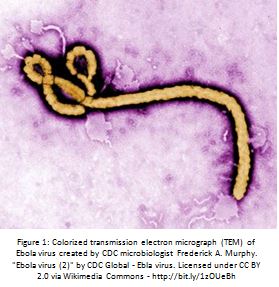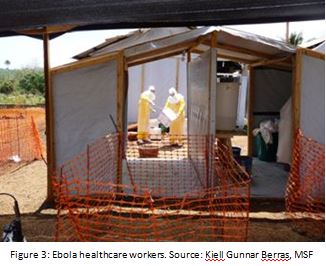EBOLA: Local contexts and future issues
Francesco Cecon, IAMP
 The current Ebola outbreak has been the deadliest so far. With the initial case traced back to December 2013, as of December 2014 it has affected more than 18,000 people, killing some 7,000. Ebola Virus Disease (EVD), first discovered in 1976 in Democratic Republic of Congo, spread from the initial case in Guinea to two other West African countries in early 2014. Specifically, the outbreak started in a village in one of Guinea’s rural districts and subsequently spread to neighbouring Liberia and Sierra Leone with cases now appearing also in Mali.
The current Ebola outbreak has been the deadliest so far. With the initial case traced back to December 2013, as of December 2014 it has affected more than 18,000 people, killing some 7,000. Ebola Virus Disease (EVD), first discovered in 1976 in Democratic Republic of Congo, spread from the initial case in Guinea to two other West African countries in early 2014. Specifically, the outbreak started in a village in one of Guinea’s rural districts and subsequently spread to neighbouring Liberia and Sierra Leone with cases now appearing also in Mali.
But what makes this outbreak different from earlier ones?
And what are the reasons that best explain its rapid diffusion in the affected West African countries?
A large part of the answer to these questions lies in three major factors: war, poverty and underdevelopment. Therefore, their unpreparedness prior to the outbreak should not come as any surprise.
Guinea ranks 183rd (out of 187) in the Human Development Index, with Liberia and Sierra Leone ranking 175th and 179th, respectively. The general situation in the West African region is not any better. Indeed, Togo ranks 166th, Cote d’Ivoire 171st, Gambia 172nd, Mali 176th, Guinea-Bissau 177th, Burkina Faso 181st, and Niger 187th. These countries are most likely at risk and their inadequate development performances put them in a situation of serious unpreparedness. (On the brighter side, Nigeria (ranked 152nd) and Senegal (ranked 163rd) both managed to identify and isolate infected patients, trace their contacts, and thus contain potential outbreaks). Analysing each affected country’s situation before the disease emerged is hence useful for understanding the role played by underdevelopment in the continuing spread of the disease.
With two successive civil wars (1989-1997 and 1999-2003), internal conflict in Liberia has left some 750,000 people dead and destroyed the country’s fledgling economy and infrastructure. With its hospitals destroyed and medical personnel killed or having fled, there was no hope that the Liberian healthcare system could deal with such a large outbreak of any disease, let alone one as highly contagious and deadly as Ebola. In fact, when Ebola arrived from Guinea, the country had only about 50 doctors to take care of its 3 million citizens (equivalent to 0.08 per 1,000 people). To this day, the capital, Monrovia, remains without mains electricity and running water, while corruption, unemployment and illiteracy are the order of the day. Some 85% of the population lives below the international poverty line, surviving on less than US$1.25 a day. Thus, drastic underdevelopment was already problematical and this recent Ebola outbreak has wiped out any recent progress made since the 2003 peace agreement. The recovery process from such a hard hit on Liberian society will require strong national and international efforts, as well as an efficient implementation plan based on a long-term strategy.
Similarly to Liberia, Sierra Leone was also recovering from a long-lasting domestic war which ended in 2002 and, even though there have been substantial improvements in the country’s economy since then, the current Ebola outbreak has made reconstruction more difficult. The civil war, which began in 1991, killed more than 50,000 people and displaced some two million others. Not surprisingly, the healthcare system has also been compromised. Indeed, the conflict left the healthcare system in a shambles, with severe shortages of medical personnel and equipment. Life expectancy in the country (circa 48/49 years) is in fact one of the lowest in the world, exacerbated by the fact that, before the outbreak, there were only 0.6 physicians per 1,000 people. Again, such a low number of doctors, most of them focused in urban areas, has facilitated the circulation of the disease from rural areas to the state’s large concentrated urban areas, like the capital Freetown and its extensive slums.
Although Guinea did not experience a civil war, the political instability and high levels of underdevelopment characterizing the country’s history have had a strong impact on its unpreparedness. Also in this case, the country was experiencing a severe lack of adequate medical equipment and personnel. In fact, before the outbreak there was just 1.0 physician per 1,000 people. Furthermore, in urbanized areas there is a severe housing shortage and access to hygiene and sanitation are therefore compromised. It was also in a rural area of Guinea where this current outbreak originated. The majority of the state’s rural districts are isolated from the cities and access to primary healthcare facilities is often made impossible by the absence of any decentralized infrastructure system.
The lack of physicians can also be taken as a proxy for the lack of clinics/care centres and hospital beds in general. Comparing the above data to that of Western countries is useful to better understand the worrying reality of the healthcare system situation in these situations. The World Health Organization estimates that adequate primary healthcare services require at least 2.3 healthcare workers per 1,000 people. For instance, the USA has an average of 2.42 physicians per 1,000 people, the UK 2.77 and Italy circa 3.8 physicians per 1,000 people. It is thus clear that in countries where there is a significant lack of trained medical personnel, there is a high probability that communicable diseases are likely to be uncontrollable, even at the very beginning of an outbreak. It also clear that, in states that have suffered political insecurity and underdevelopment, basic healthcare services are not well delivered by governments. In the case of Ebola, where early treatment and proper hygiene care are indispensable elements for preventing transmission, the lack of health facilities and medical personnel made the initial outbreak unmanageable. Coupled with late national and international responses, these factors can be blamed for the dramatic spread of the disease.
Arguably, too, the human toll is not limited to those individuals who have actually contracted Ebola but is extended to those who are dying of other diseases that were already lethal before the outbreak, including malaria, diarrhoea and tuberculosis. In affected areas, healthcare services are often not being delivered to the local population and people with diseases other than Ebola do not go to the hospitals or other health facilities because they are scared of the possibility of contracting the virus. Even pregnant women who would prefer to go to a hospital or clinic to give birth are steering clear of health facilities – often to their own and their babies’ detriment.
Problems of communication also influence people’s response to the virus. There are issues of distrust, suspicion and panic. People do not know much about the virus – especially as this is the first time it has appeared in West Africa – and therefore fear takes over. In addition, local cultures and traditions for treating patients have also helped to spread the disease. For instance, safe burial practices can help to slow down the spread of the virus and prevent the infection of healthy individuals. However, several local communities in West Africa practice traditional ways of treating the corpses that often include washing hands with the same water used to clean the bodies, exponentially exposing themselves to the disease.

And as the virus continues to spread, it is destroying the social fabric of the affected countries, making any future recovery realistically long and drawn-out. The economy of these states is in fact being devastated by the outbreak. Neighbouring countries have closed their borders. With cross-border trade blocked, people are losing one of their main sources of income. Many non-neighbouring countries have also stopped flights with these nations, increasing their isolation. For fear of contact with others, people do not go to work, the agricultural sector is no longer providing food, and internal markets are completely stuck. Many have thus lost any means of subsistence they once had. Poverty, already severe, is a growing reality in these societies and will continue to have an impact once the outbreak is over. Besides reconstructing some form of health system in these countries, the endemic poverty will be the first emergency that will need to be addressed.
Moreover, in these countries, there are substantial differences between urban and rural areas. Communities in rural districts are often very distant from basic healthcare facilities and rely on traditional ways of healing. Yet, guaranteeing some basic health infrastructure and training to selected individuals would prevent, or at least help contain, possible future outbreaks. In the case of Ebola, having such a planning would have most likely controlled the spread of the virus, enhancing the chances of preventing its arrival in large metropolitan area. Also, considering that people who inhabit rural districts have more contact with wildlife, the introduction of some form of education on approaching wild animals in these districts could also represent a good prevention method. Fruit bats, for example, are the principal Ebola-carrying animals and are commonly hunted and eaten in West Africa. Issues of discrimination in access to health services need to be taken into account as well. In these countries, access is not guaranteed to everyone. The gap between rich and poor, men and women, and between different ethnic groups – among other things – is growing at an alarming pace.
How can any future outbreak be prevented if access to treatment is not provided equitably?
This is just one of the questions that will need to be answered when planning rebuilding strategies. At the moment, the international community is rightly focusing on containing and eventually stopping the outbreak. Yet the factors that allowed such a huge outbreak to spread out of control for so long (it was not until August 2014 that the WHO declared the epidemic to be an international public health emergency) should not be forgotten. Indeed, the current Ebola outbreak might provide a harsh but proper lesson from which to learn. There is clearly a need for a systematic overhaul of the healthcare services in the affected countries (among other “at-risk” countries). Such a significant ramp-up of these nations’ health service capacities will require the concerted efforts of the national governments, the international community, academia, including academies of science and medicine, foundations and non-governmental organizations. While 2015 will hopefully see the epidemic finally being brought under control, now is the time for all these agencies to begin developing the master plan for how to assist these countries in the aftermath of the outbreak so that another such outbreak does not have the chance to spread beyond its initial focus.

Francesco Cecon
Masters of International Relations
IAMP intern, November-December 2014
USEFUL LINKS
Make Ebola a life-saving lesson by Souleymane Mboup, member of TWAS and ANST: http://twas.org/article/make-ebola-life-saving-lesson
‘IAMP and Ebola’: http://www.iamp-online.org/content/iamp-and-ebola



